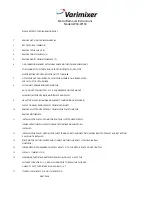
GLOSSARY-III
Revision S2005-6
S-Type
DC Group
A direct current bus that controls the VCA drive
voltage.
DC Master
DC controlled fader serving as a master fader to
which one or more channel faders has been
assigned.
DC Master assignment
Assignment of one or more channel faders to a
Master fader.
DC master membership
Channel fader assigned to a certain DC Master
fader.
dedicated stereo bus
Bus exclusively used for stereo signals
destructive SOLO
Pressing CHECK will invert the MUTE-function
so that all unmuted channels will become muted
and the muted channel will become unmuted. A
form of SOLO function.
Differential mode
Currents flowing in a pair of signal lines that are
principally concerned with the signals them-
selves. Any induced interference on either line
appears to be in common mode with respect to
the signal currents (differential or normal mode)
and thus cancel.
DIM
Feature on the Listen & Stereo output module
that attenuates the Listen L/S outputs 1 and 2
by approximately 20dB.
Direct Output Select
The direct output signal is normally post fader.
Pressing the PRE button will take the signal
from pre-fader but post INS/EQ. Pressing MIC
will override the PRE button (the PRE LED will
go out) taking the d/o directly from the o/p of the
MIC amp. In this state the highpass filter is still
available if needed.
dual group
Group module with odd end even mixing amplifi-
ers.
dual mono
A group module configured for dual mono oper-
ation.
EARTH IMPEDANCE
The total opposition to the flow of current in a
dedicated earth conductor. At frequencies
above 50/60 Hz, the total opposition to current
flow will be more inductive than resistive in the
context used (power supply mains connections),
Best results are achieved if the length of the AC
power input cables to the main and backup
PSUs are the same.
electro-magnetic interference
Radiated and conducted phenomena associ-
ated with the electric and magnetic fields gener-
ated unintentionally by electronic circuits and
systems.
electronically balanced input
An electronic amplifier stage used to amplify the
difference voltage between two input signals. In
the ideal case the output is entirely independent
of the individual signal levels - only the differ-
ence matters. This type of circuit is also known
as a differential amplifier. When the input signal
is fed from a balanced line, the common mode
rejection to interference signals is extremely
good. In other words, a good differential ampli-
fier has a high common mode rejection ratio
(CMRR).
Summary of Contents for S-Type
Page 1: ...Audio Mixing Console 056 6 10 n 95 4 1 07 7g8 2...
Page 4: ...iv Table of Contents S Type Revision S2005 6...
Page 6: ...vi Introduction S Type Revision S2005 6...
Page 10: ...1 4 System overview S Type Revision S2005 6...
Page 16: ...2 6 Connections and setup S Type Revision S2005 6...
Page 28: ...4 10 Mono input module 8411 S Type Revision S2005 6...
Page 38: ...5 10 Stereo input module 8412 S Type Revision S2005 6...








































